《跨文化交际》课程教学大纲及样卷
- 格式:doc
- 大小:109.50 KB
- 文档页数:9
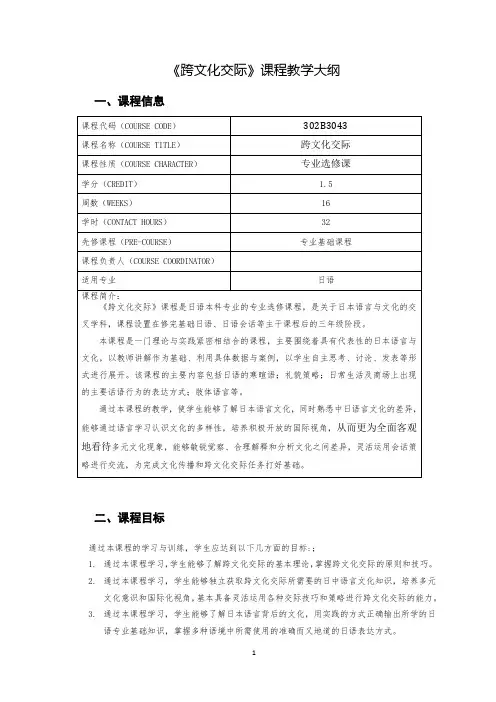
《跨文化交际》课程教学大纲
一、课程信息
二、课程目标
通过本课程的学习与训练,学生应达到以下几方面的目标:;
1.通过本课程学习,学生能够了解跨文化交际的基本理论,掌握跨文化交际的原则和技巧。
2.通过本课程学习,学生能够独立获取跨文化交际所需要的日中语言文化知识,培养多元
文化意识和国际化视角,基本具备灵活运用各种交际技巧和策略进行跨文化交际的能力。
3.通过本课程学习,学生能够了解日本语言背后的文化,用实践的方式正确输出所学的日
语专业基础知识,掌握多种语境中所需使用的准确而又地道的日语表达方式。
4.通过本课程学习,学生能够了解跨文化交际所需要的中日文化知识,培养中日语言文化
对比能力,提高实际语言运用能力和交际应变能力。
课程目标对毕业要求的支撑关系表
三、教学内容与预期学习成效
3
4
5
6
四、成绩评定及考核方式
7
8
五、课程建议教材及主要参考资料
1.建议教材
1. 张韶岩(编).中日跨文化交际实用教材华东理工大学出版社,2012年
2.主要参考书
1. 滝浦真人. ポライトネス入門研究社出版,2008年
2. 周平、陈小芬. 新编日语 1、2册(重排版),上海外语教育出版社,2016年
9。
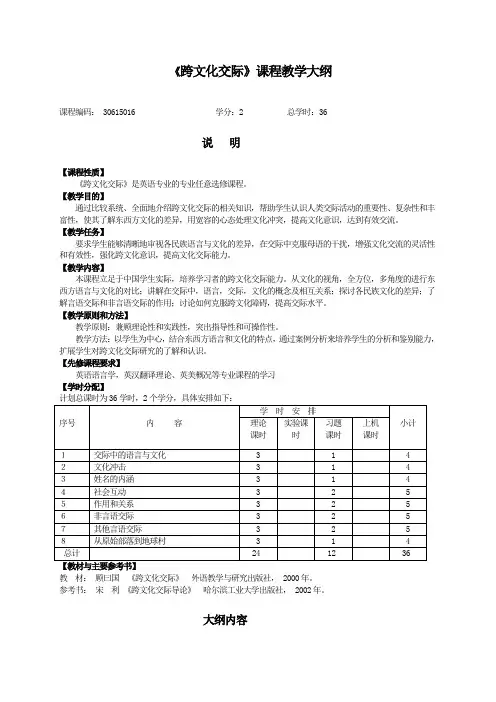
《跨文化交际》课程教学大纲课程编码: 30615016 学分:2 总学时:36说明【课程性质】《跨文化交际》是英语专业的专业任意选修课程。
【教学目的】通过比较系统、全面地介绍跨文化交际的相关知识,帮助学生认识人类交际活动的重要性、复杂性和丰富性,使其了解东西方文化的差异,用宽容的心态处理文化冲突,提高文化意识,达到有效交流。
【教学任务】要求学生能够清晰地审视各民族语言与文化的差异,在交际中克服母语的干扰,增强文化交流的灵活性和有效性,强化跨文化意识,提高文化交际能力。
【教学内容】本课程立足于中国学生实际,培养学习者的跨文化交际能力。
从文化的视角,全方位,多角度的进行东西方语言与文化的对比;讲解在交际中,语言,交际,文化的概念及相互关系;探讨各民族文化的差异;了解言语交际和非言语交际的作用;讨论如何克服跨文化障碍,提高交际水平。
【教学原则和方法】教学原则:兼顾理论性和实践性,突出指导性和可操作性。
教学方法:以学生为中心,结合东西方语言和文化的特点,通过案例分析来培养学生的分析和鉴别能力,扩展学生对跨文化交际研究的了解和认识。
【先修课程要求】英语语言学,英汉翻译理论、英美概况等专业课程的学习【学时分配】教材:顾曰国《跨文化交际》外语教学与研究出版社, 2000年。
参考书:宋利《跨文化交际导论》哈尔滨工业大学出版社, 2002年。
大纲内容第一部分交际中的语言和文化【教学目的和要求】教学目的:学生了解交际的种类;懂得交际的基本要素;学会交流的基本模式;了解文化交际的内涵。
教学要求:要求学生掌握文化交际的互动过程;认知不同的社会条件;熟悉非言语交际所传递的信息;了解交际的作用。
【内容提要】第一节语言与文化第二节交际的基本要素第三节交际的基本模式第四节交际的文化内涵第五节社会交流第六节跨文化交际【教学重点与难点问题】教学重点:语言、文化、交际、跨文化交际的概念;文化交际的基本要素;文化的特点教学难点:语言与文化的关系;文化与交际的关系【复习参考题】1.如何理解语言与文化的关系?2.如何看待文化与交际的关系?第二部分文化冲击【教学目的和要求】教学目的:学生了解英汉民族在好客、谦逊、隐私等方面存在的差异;学会鉴别东西方不同的文化理念;适应新的文化环境。
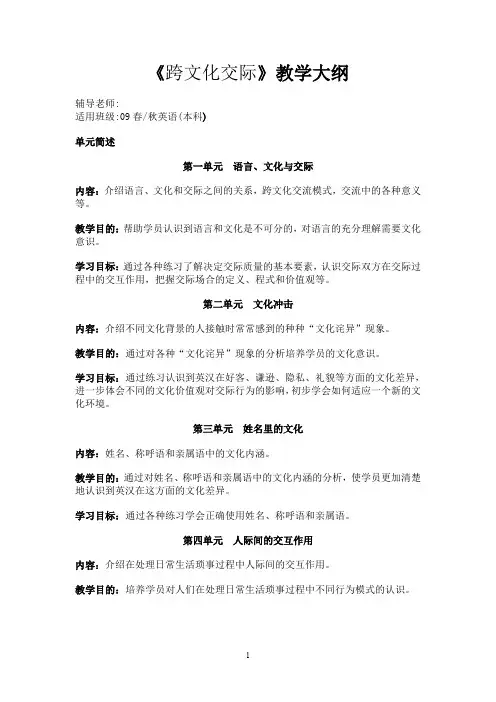
《跨文化交际》教学大纲辅导老师:适用班级:09春/秋英语(本科)单元简述第一单元语言、文化与交际内容:介绍语言、文化和交际之间的关系,跨文化交流模式,交流中的各种意义等。
教学目的:帮助学员认识到语言和文化是不可分的,对语言的充分理解需要文化意识。
学习目标:通过各种练习了解决定交际质量的基本要素,认识交际双方在交际过程中的交互作用,把握交际场合的定义、程式和价值观等。
第二单元文化冲击内容:介绍不同文化背景的人接触时常常感到的种种“文化诧异”现象。
教学目的:通过对各种“文化诧异”现象的分析培养学员的文化意识。
学习目标:通过练习认识到英汉在好客、谦逊、隐私、礼貌等方面的文化差异,进一步体会不同的文化价值观对交际行为的影响,初步学会如何适应一个新的文化环境。
第三单元姓名里的文化内容:姓名、称呼语和亲属语中的文化内涵。
教学目的:通过对姓名、称呼语和亲属语中的文化内涵的分析,使学员更加清楚地认识到英汉在这方面的文化差异。
学习目标:通过各种练习学会正确使用姓名、称呼语和亲属语。
第四单元人际间的交互作用内容:介绍在处理日常生活琐事过程中人际间的交互作用。
教学目的:培养学员对人们在处理日常生活琐事过程中不同行为模式的认识。
学习目标:通过练习学会处理邀请、约会、付帐、馈赠、请求、恭维、招待等行为中的文化差异,了解其中的一些不成文规则,更清楚地意识到自己的行为是如何受本族文化影响的。
第五单元角色和关系内容:介绍社会角色,如男和女、父母和孩子、朋友、社会身份等中的文化内涵。
教学目的:帮助学员分析社会角色和关系在不同文化中的期望值。
学习目标:意识到不同角色的不同期望值;意识到不同角色的不同责任;做到同其他文化背景的人交往时能够调整自己的期望值。
第六单元体态语交流内容:介绍体态语在跨文化交际中的重要作用。
教学目的:使学员熟悉不同种类的体态语以及不同文化对体态语的不同解释。
学习目标:通过练习能够描述体态语的不同意义;意识到成功的跨文化交际不仅需要知道如何用语言表达,而且要知道伴随恰当的体态语,在交流中有意识地注意脸部表情、目光接触、手势和身体位置、身体距离等。
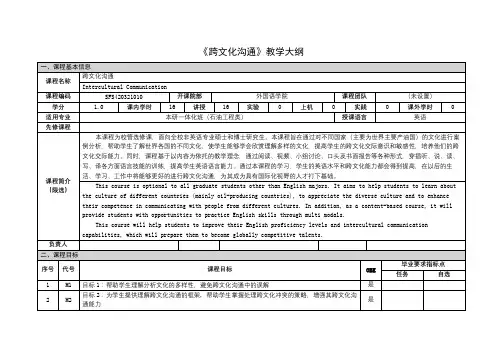
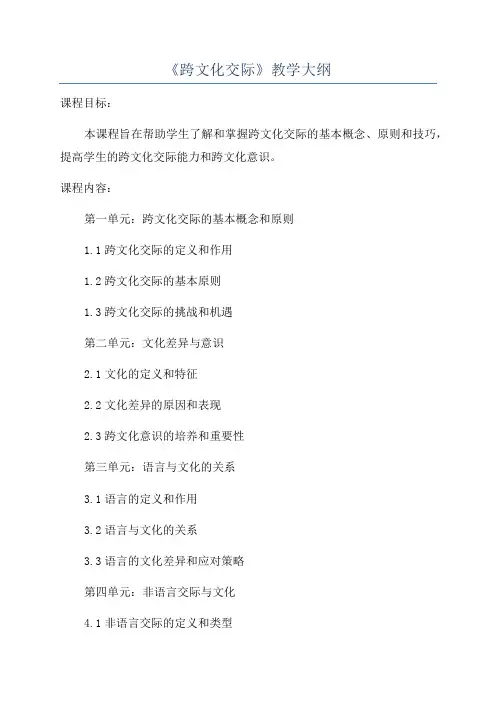
《跨文化交际》教学大纲课程目标:本课程旨在帮助学生了解和掌握跨文化交际的基本概念、原则和技巧,提高学生的跨文化交际能力和跨文化意识。
课程内容:第一单元:跨文化交际的基本概念和原则1.1跨文化交际的定义和作用1.2跨文化交际的基本原则1.3跨文化交际的挑战和机遇第二单元:文化差异与意识2.1文化的定义和特征2.2文化差异的原因和表现2.3跨文化意识的培养和重要性第三单元:语言与文化的关系3.1语言的定义和作用3.2语言与文化的关系3.3语言的文化差异和应对策略第四单元:非语言交际与文化4.1非语言交际的定义和类型4.2非语言交际的文化差异4.3非语言交际的意义和应用第五单元:跨文化沟通技巧5.1有效倾听与观察5.2调整自己的言语和行为5.3解决跨文化沟通中的问题和冲突教学方法:本课程将采用多元化的教学方法,包括讲授、案例分析、讨论、小组活动和角色扮演等。
评估方式:1.平时表现:包括课堂参与、小组活动表现等。
2.课堂作业:包括课后练习、案例分析报告等。
3.期末考试:对学生对课程内容的综合理解和应用能力进行考核。
参考教材:3. Bennett, M.J. (1993). Towards Ethnorelativism: A Developmental Model of Intercultural Sensitivity. In R. M. Paige (Ed.), Education for the Intercultural Experience (pp. 21-71). Yarmouth, ME: Intercultural Press.教学大纲制定者:XXX教授。
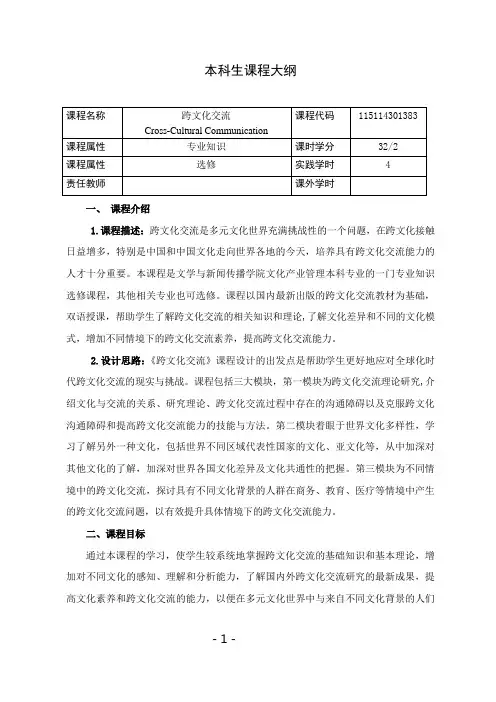
本科生课程大纲一、课程介绍1.课程描述:跨文化交流是多元文化世界充满挑战性的一个问题,在跨文化接触日益增多,特别是中国和中国文化走向世界各地的今天,培养具有跨文化交流能力的人才十分重要。
本课程是文学与新闻传播学院文化产业管理本科专业的一门专业知识选修课程,其他相关专业也可选修。
课程以国内最新出版的跨文化交流教材为基础,双语授课,帮助学生了解跨文化交流的相关知识和理论,了解文化差异和不同的文化模式,增加不同情境下的跨文化交流素养,提高跨文化交流能力。
2.设计思路:《跨文化交流》课程设计的出发点是帮助学生更好地应对全球化时代跨文化交流的现实与挑战。
课程包括三大模块,第一模块为跨文化交流理论研究,介绍文化与交流的关系、研究理论、跨文化交流过程中存在的沟通障碍以及克服跨文化沟通障碍和提高跨文化交流能力的技能与方法。
第二模块着眼于世界文化多样性,学习了解另外一种文化,包括世界不同区域代表性国家的文化、亚文化等,从中加深对其他文化的了解,加深对世界各国文化差异及文化共通性的把握。
第三模块为不同情境中的跨文化交流,探讨具有不同文化背景的人群在商务、教育、医疗等情境中产生的跨文化交流问题,以有效提升具体情境下的跨文化交流能力。
二、课程目标通过本课程的学习,使学生较系统地掌握跨文化交流的基础知识和基本理论,增加对不同文化的感知、理解和分析能力,了解国内外跨文化交流研究的最新成果,提高文化素养和跨文化交流的能力,以便在多元文化世界中与来自不同文化背景的人们- 1 -进行有效交流和合作,助益未来事业的跨文化发展,也为以后从事对外交流与跨文化传播打下有益的基础。
三、学习要求要完成所有的课程任务,学生必须:(1)按时上课,认真投入,积极参与课堂讨论、课堂练习和讲演展示,课堂表现和出勤率是成绩考核的组成部分。
(2)按时按要求完成课后巩固练习作业和课前预习预热作业。
这两者对于学生掌握课程内容和课堂教学的展开都非常重要,都要求认真对待并积极完成。

修订版《跨文化交际》教学大纲引言:《跨文化交际》是一门有着重要意义的课程,旨在帮助学生更好地理解和应对不同文化背景下的交际挑战。
本教学大纲旨在修订原有的教学内容,以更好地满足学生需求和社会发展的要求。
一、课程目标:1.理解跨文化交际的概念和重要性。
2.学习不同文化背景下的交际方式和礼仪。
3.培养跨文化沟通能力和解决跨文化冲突的能力。
4.了解不同文化在商务、教育和社交等领域的影响。
5.提高自身的跨文化适应能力和文化敏感性。
二、教学内容:1.跨文化交际的概念和重要性a.介绍跨文化交际的定义和范围。
b.分析跨文化交际的重要性和意义。
c.探讨全球化背景下跨文化交际的挑战。
2.文化差异的认知a.介绍文化差异的概念和分类。
b.分析不同文化中的价值观、信念和行为模式。
c.比较不同文化的沟通风格和非语言交际。
3.跨文化交际中的交际策略a.介绍跨文化交际中的常见问题和挑战。
b.探讨有效的交际策略和技巧。
c.培养学生的非言语交际和倾听技巧。
4.跨文化冲突与解决a.分析跨文化冲突的原因和影响。
b.介绍跨文化冲突的解决方法和技巧。
c.案例分析和角色扮演,让学生实践解决冲突的能力。
5.文化影响与应用a.介绍不同文化在商务、教育和社交等领域的影响。
b.分析全球化背景下的文化融合和文化独特性。
c.讨论如何在不同文化场景中合理应用文化差异。
6.跨文化适应和文化敏感性培养a.介绍跨文化适应的重要性和方法。
b.探讨培养文化敏感性的途径和技巧。
c.组织跨文化体验活动,提高学生的跨文化适应能力。
三、教学方法:1.多媒体教学:使用图片、视频和教学软件引入跨文化交际的概念和案例。
2.讨论和演练:组织小组讨论和角色扮演,让学生实践跨文化交际的技巧和策略。
3.案例分析:通过案例分析,让学生理解跨文化交际中的挑战和解决方法。
4.互动教学:鼓励学生互相分享自己跨文化交际的经验和故事。
5.实践活动:组织跨文化体验活动,让学生亲身感受不同文化背景下的交际挑战。

跨文化交际课程教学大纲一、课程简介跨文化交际是指在多文化背景下进行有效沟通和合作的能力。
跨文化交际课程旨在培养学生在不同文化背景下的适应能力、理解能力和沟通技巧。
通过本课程的学习,学生将能够更好地跨越语言和文化的障碍,增进国际间的理解与友谊。
二、课程目标本课程的主要目标是帮助学生:1.了解不同文化之间的差异和相似之处;2.掌握跨文化交际的基本原则和技巧;3.培养与不同文化背景的人沟通与合作的能力;4.增进对其他文化的尊重、欣赏和理解。
三、教学内容本课程将涵盖以下主题:1.文化概论a) 文化的定义和特点b) 文化对个人和社会的影响c) 多元文化主义的概念和重要性2.文化差异与文化冲突a) 文化差异的原因和表现形式b) 不同文化之间的冲突和误解c) 跨文化冲突的解决方法3.跨文化交际的基本原则a) 尊重他人的文化和价值观b) 适应不同的礼节和行为准则c) 理解和应对文化差异4.误解和歧视a) 语言和行为的误解b) 非理性的偏见和歧视c) 打破误解和歧视的方法和策略5.跨文化交际的实践a) 跨文化团队合作b) 跨文化销售与市场营销c) 跨文化外交与国际关系四、教学方法本课程将采用多种教学方法,以促进学生的参与和互动。
主要教学方法包括:1.讲授:教师通过讲解理论和案例,介绍跨文化交际的基本知识和技巧;2.案例分析:通过分析真实的跨文化交际案例,让学生理解其中存在的文化差异和问题;3.讨论:通过小组讨论和全班讨论的形式,促进学生对跨文化交际问题的思考和理解;4.角色扮演:通过角色扮演的方式,让学生亲身体验跨文化交际中可能遇到的情境,并提供解决问题的实践机会;5.案例研究:学生将选择一个真实的跨文化案例,并进行深入的研究和分析,以展示他们的学习成果。
五、评估方式本课程的评估方式将包括以下几个方面:1.平时表现:包括出勤情况、参与度和小组合作等;2.课堂作业:包括阅读理解、写作和案例分析等;3.个人报告:学生需选择一个跨文化交际案例,进行深入研究和报告;4.期末考试:综合考察学生对跨文化交际原理和技巧的理解和运用能力。
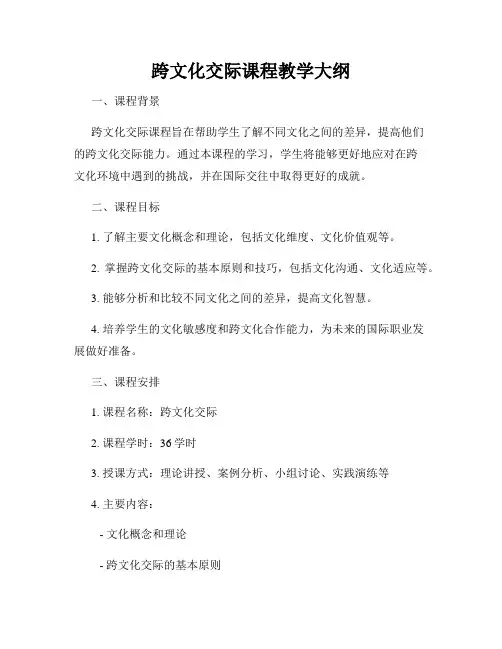
跨文化交际课程教学大纲一、课程背景跨文化交际课程旨在帮助学生了解不同文化之间的差异,提高他们的跨文化交际能力。
通过本课程的学习,学生将能够更好地应对在跨文化环境中遇到的挑战,并在国际交往中取得更好的成就。
二、课程目标1. 了解主要文化概念和理论,包括文化维度、文化价值观等。
2. 掌握跨文化交际的基本原则和技巧,包括文化沟通、文化适应等。
3. 能够分析和比较不同文化之间的差异,提高文化智慧。
4. 培养学生的文化敏感度和跨文化合作能力,为未来的国际职业发展做好准备。
三、课程安排1. 课程名称:跨文化交际2. 课程学时:36学时3. 授课方式:理论讲授、案例分析、小组讨论、实践演练等4. 主要内容:- 文化概念和理论- 跨文化交际的基本原则- 文化差异分析与比较- 文化冲突与解决- 跨文化沟通技巧- 跨文化适应能力培养- 跨文化合作案例研究四、评估方式1. 期中考试2. 课堂表现3. 作业4. 期末论文五、教材及参考书目1. 主教材:《跨文化交际》2. 参考书目:- 《跨文化交际能力培养》 - 《全球商务交际实务》 - 《国际文化比较》六、教学团队本课程教师将由具有丰富跨文化交际经验和教学经验的专业人士担任,确保学生能够获得高质量的教学服务。
七、总结跨文化交际课程是培养学生国际化视野和文化广度的重要课程,通过本课程的学习,希望能够帮助学生更好地适应多元文化社会,提高国际竞争力,为未来的职业生涯奠定坚实基础。
愿学生在这门课程中有所收获,不断提升自我跨文化交际能力。
《跨文化交际》课程教学大纲课程编码: 30615016 学分:2 总学时:36说明【课程性质】《跨文化交际》是英语专业的专业任意选修课程。
【教学目的】通过比较系统、全面地介绍跨文化交际的相关知识,帮助学生认识人类交际活动的重要性、复杂性和丰富性,使其了解东西方文化的差异,用宽容的心态处理文化冲突,提高文化意识,达到有效交流。
【教学任务】要求学生能够清晰地审视各民族语言与文化的差异,在交际中克服母语的干扰,增强文化交流的灵活性和有效性,强化跨文化意识,提高文化交际能力。
【教学内容】本课程立足于中国学生实际,培养学习者的跨文化交际能力。
从文化的视角,全方位,多角度的进行东西方语言与文化的对比;讲解在交际中,语言,交际,文化的概念及相互关系;探讨各民族文化的差异;了解言语交际和非言语交际的作用;讨论如何克服跨文化障碍,提高交际水平。
【教学原则和方法】教学原则:兼顾理论性和实践性,突出指导性和可操作性。
教学方法:以学生为中心,结合东西方语言和文化的特点,通过案例分析来培养学生的分析和鉴别能力,扩展学生对跨文化交际研究的了解和认识。
【先修课程要求】英语语言学,英汉翻译理论、英美概况等专业课程的学习【学时分配】教材:顾曰国《跨文化交际》外语教学与研究出版社, 2000年。
参考书:宋利《跨文化交际导论》哈尔滨工业大学出版社, 2002年。
大纲内容第一部分交际中的语言和文化【教学目的和要求】教学目的:学生了解交际的种类;懂得交际的基本要素;学会交流的基本模式;了解文化交际的内涵。
教学要求:要求学生掌握文化交际的互动过程;认知不同的社会条件;熟悉非言语交际所传递的信息;了解交际的作用。
【内容提要】第一节语言与文化第二节交际的基本要素第三节交际的基本模式第四节交际的文化内涵第五节社会交流第六节跨文化交际【教学重点与难点问题】教学重点:语言、文化、交际、跨文化交际的概念;文化交际的基本要素;文化的特点教学难点:语言与文化的关系;文化与交际的关系【复习参考题】1.如何理解语言与文化的关系?2.如何看待文化与交际的关系?第二部分文化冲击【教学目的和要求】教学目的:学生了解英汉民族在好客、谦逊、隐私等方面存在的差异;学会鉴别东西方不同的文化理念;适应新的文化环境。
教学要求:要求学生认知禁忌话题;学会克服文化障碍;了解适应文化环境的方法。
【内容提要】第一节好客习俗第二节谦逊表达第三节隐私理念第四节集体主义和个体主义第五节文化调整第六节文化适应【教学重点与难点问题】教学重点:东西方在好客方面的差异、东西方在隐私方面的差异教学重点:集体主义和个体主义的差异【复习参考题】1.如何理解东西方在待人接物方面的差异?2.如何看待东西方不同的隐私观念?第三部分姓名的内涵【教学目的和要求】教学目的:学生了解英汉姓名的结构差异;掌握姓名缩略语的使用;讨论英汉姓名的历史起源;联想姓名与命运的关系。
教学要求:分析男女姓名的差异;避免性别歧视;掌握东西方的称谓差异。
【内容提要】第一节姓名的结构第二节姓名的起源第三节东西方称谓差异第五节男女姓名的差异【教学重点与难点问题】教学重点:东西方姓名的结构差异、姓名的文化内涵、东西方姓名的起源教学难点:英汉称谓差异、男女姓名差异【复习参考题】1.如何理解东西方姓名结构的差异?2.如何看待东西方称谓差异?第四部分社会交往【教学目的和要求】教学目的:学生了解不同的邀请习俗;学习东西方不同的时间观念;掌握英汉民族赴餐、送礼、饮食、赞颂的不同习俗。
教学要求:要求学生辨别英汉民族的行为差异;学会避免跨文化交际中的误会,进行有效交流。
【内容提要】第一部分邀请习俗第二部分赴宴习俗第三部分送礼习俗第四部分赞颂习俗【教学重点与难点问题】教学重点:东西方时间观念的差异、不同的赴餐、送礼、饮食、赞颂习俗教学难点:东西方不同的好客方式、与饮食相关的习语、东西方不同的赞颂习俗【复习参考题】1. 如何理解东西方的邀请习俗的差异?2. 如何理解东西方人接受礼物的不同方式?第五部分作用与关系【教学目的和要求】教学目的:学生能够了解东西方教育模式的差异;理解男女性别的言语和行为差异。
教学要求:认知男女交际的差异;掌握东西方友谊观念的不同;【内容提要】第一节家庭观念第二节教育模式第三节亲情关系第四节男女交流第五节友谊观念【教学重点与难点问题】教学重点:了解东西方家庭教育模式的差异;探究产生教育差异的原因;理解东西方不同的文化视角;了解中国传统的家庭教育原则。
教学难点;男女性别的言语和行为差异;不同的友谊表达方式【复习参考题】1.东西方家庭模式的差异是什么?2.男女性别言语和行为差异是什么,探究产生的根源。
3.讨论东西方不同的友谊观。
第六部分非言语交际【教学目的和要求】教学目的:学生能够了解非言语交际的概念极其作用;解释在跨文化交际中手语内涵;认知目光交流的作用。
教学要求:要求学生通过言语交际和非言语交际成功获得文化认知。
【内容提要】第一节非言语交际的目的第二节非言语交际的定义第三节手语内涵第四节面目表情第五节目光注视第六节体距差异【教学重点与难点问题】教学重点:非言语交际的概念、非言语交际的作用、手语的内涵教学难点:掌握目光交流的方式;了解东西方体距的差异。
【复习参考题】1.如何辨别不同国家的手语内涵?2.东西方体距差异有何不同?第七部分其他的言语交际【教学目的和要求】教学目的:学生能够了解近义词、习语、谚语、俚语、禁忌语和委婉语的概念及使用。
教学要求:了解英汉习语的翻译;揭示英汉谚语的特点;解释俚语的内涵;比较英式英语和美式英语的异同。
【内容提要】第一节近义词第二节习语第三节俚语第四节谚语第五节禁忌语第六节委婉语【教学重点与难点问题】教学重点:英式英语和美式英语的异同、习语的概念及其翻译、习语的拓展教学难点:英汉谚语的互译;俚语、禁忌语和委婉语的使用【复习参考题】1.英式英语和美式英语的差异是什么?2.如何进行英汉习语翻译?3.如何翻译英汉谚语?4.如何使用俚语,禁忌语和委婉语?第八部分从原始部落到地球村【教学目的和要求】教学目的:学生能够了解人类交流的历史历程;认识科学技术的发展对世界交流的作用。
教学要求:要求学生比较人类与动物的交际差异;学会利用高科技进行文化交流。
【内容提要】第一节原始交流方式第二节人类的首次拓展第三节人类的第二次拓展---- 距离与时间的超越第四节人类的第三次拓展——电脑代替人脑第五节地球村【教学重点与难点问题】教学重点:学习语言的产生经过;了解电报的作用;认识电视交流的进步。
教学难点:电脑如何推进人类的发展;人际交流的发展。
【复习参考题】1.比较人类交际与动物交际的差异。
2.如何理解地球村的概念及其内涵?执笔人:审核人:《跨文化交际》课程考核大纲【考核目的】了解学生对东西方文化差异的感知能力,帮助学生处理文化差异产生的障碍,全面提高学生的综合素质。
考核学生是否具备与不同文化背景的人们进行交流的能力。
【课程学习的基础】语言学,英汉翻译,报刊阅读等课程。
(这些知识不在考试范围之内)【考核的内容范围】考核学生对跨文化交际的基本概念和理论知识的了解;检查学生如何理解在交际中,语言与文化,文化与交流的关系;探讨东西方不同的思维模式;认知言语交际和非言语交际的作用。
通过考试了解学生如何运用所学的理论知识克服跨文化交际中出现的障碍,提高交际效果。
【考试方法】期末开卷笔试,占60%,平时考核(出勤,课堂表现,作业)占40%【对试题的要求】1.题型比例:客观性试题占60%,包括概念题、单选题、判断题、匹配题等;主观性试题占40%,包括简答题、论述题、案例分析题等。
2.难度等级:分为较易、中等、较难三个等级,大致比例是40:40:20【考试的具体内容】第一部分交流中的语言和文化知识点:1.交际的概念 2.交际的要素 3.交际的基本模式 4.交际的特点 5. 语言的概念6.文化的概念及特点7.语言与文化的关系8.文化与交际的关系 9.跨文化交际的概念考核目标:1.识记:文化、交际、语言、跨文化交际的基本概念2.理解:(1)交际的基本模式(2)交际的特点(3)交际的基本要素(4)文化的基本特点3.应用:(1)语言与文化的关系(2)文化与交际的关系第二部分文化冲击知识点:1.文化冲击的概念2.文化冲击的表现模式3.隐私的概念及其理解4.集体主义和个体主义的概念考核目标:1.识记:(1)文化冲击(2)隐私(3)好客(4)集体主义和个体主义的基本概念2.理解:(1)集体主义的表现形式(2)个体主义的表现形式3.应用:(1)在西方文化中如何避免禁忌话题?(2)为什么不同的文化价值观会形成不同的举止言谈?第三部分姓名的内涵知识点:1. 汉语姓名结构及历史起源2. 英语的姓名结构及历史起源3. 姓名的文化内涵4. 英语姓名缩略语的使用5. 东西方称谓差异6. 英汉称谓差异7.男女姓名的差异8. 语言与性别的关系考核目标:1.识记:(1)汉语姓名结构及历史起源(2)英语的姓名结构及历史起源2.理解:(1)如何正确使用英语姓名缩略语?(2)英汉姓名结构的差异3.应用:(1)如何理解姓名与命运的关系?(2)如何认识男女姓名存在差异?第四部分社会交往知识点:1. 东西方邀请方式的不同。
2.东西方不同的时间观念3.与赴宴相关的习语4.拒绝的表达方式5.东西方送礼习俗的差异6.英汉民族不同的好客方式7.东西方不同的赞颂习俗考核目标:1.识记:(1)与赴宴相关的习语2.理解:(1)如何理解不同的邀请习俗?3.应用:(1)如何认知英汉民族不同的好客方式?第五部分作用与关系知识点:1.教育模式的差异(比较中国的传统教育原则和澳大利亚的教育原则)。
2.东西方家庭观念的差异3.男女交际差异4.不同的友谊观5.中国传统的教育原则考核目标:1.识记:(1)中国传统的教育原则(2)友谊观2.理解:(1)如何理解男女交际中的差异?3.应用:(1)探究东西方教育差异产生的原因?第六部分非言语交际知识点:1.非言语交际的概念2.非言语交际的作用3.手语内涵4.表情内涵5.目光交流6.体距差异考核目标:1. 识记:(1)非言语交际的概念(2)非言语交际的作用2.理解:(1)如何理解不同国家的手语内涵差异?(2)如何理解面目表情所揭示的不同情感?3.应用:(1)如何掌握目光交流的有效方式?(2)探究不同国度的体距差异。
第七部分其他的言语交际语言点:1. 英式英语和美式英语的异同2.习语的概念3 .习语的翻译4 .习语的拓展5 .谚语的使用6 .俚语,禁忌语和委婉语的使用考核目标:1.识记:(1)习语概念(2)禁忌语概念(3)谚语的概念(4)俚语的概念(5)委婉语的概念2.理解:(1)了解与运动、饮食、习俗、文学、历史、动物等方面相关的习语内涵(2)英汉习语互译(3)英汉谚语的互译2.应用:(1)如何恰当地翻译英汉谚语?(2)如何使用俚语,禁忌语和委婉语?第八部分从原始部落到地球村语言点:1.语言的产生2.电报的诞生3.电视交流4 .电脑的使用5.人类交流的发展6 . 地球村考核目标:1.识记:(1)地球村的概念2.理解:(1)如何理解地球村的概念及其内涵?Array3.应用:(1)电脑是如何推进人类社会发展的?【样题】跨文化交际期末试卷I. Define the following terms(每小题3分,共15分)1.Intercultural communication (3分)2.Cultural shock (3分)3.Collectivism (3分)4.Non-verbal communication (3分)5.idiom (3分)II.Answer the following questions (每小题4分,共20分)1.State Harold Lasswell’s “5W patterns” theory (4分)2.State the relationship between culture and communication (4分)3.Describe the sorts of family structures in the society (4分)4.Illustrate the topics of compliment making in the west (4分)5.Describe the rules of the gift taking in the west (4分)III. Case Analysis(每小题5分,共20分)Case A (5分)An American couple came to Beijing to work as foreign teachers for the first time in their lives. They had a three-year-old son. Since the couple worked, they hired a Chinese housemaid, who was in her late 40s. One of her jobswas to send their son to a kindergarten in the morning and pick him up home in the afternoon. She found this the mostdifficult among all her tasks. Every day when it was time to send the boy, there was bound to be a fight, for she insisted on holding the boy in her arms or at least holding his hand; but the boy never liked it. He cried or fought for independence. He preferred to walk by himself. After a few days, she couldn’t bear it any more ,so she quit the job. Try to explain why it happened.Case B (5分)A British tourist is visiting a Chinese fam ily. The Chinese hostess introduces herself and her husband to the guest…Chinese hostess: W elcome to my home. My name is Cai Hong, and this is my husband.British tourist: Thank you, Mrs. Cai. It’s a pleasure to meet you, Mrs. Cai. I’m Lucy Taylor.Chinese hostess: Have a seat, Madam Lucy.Can you identify the mistake use of names and titles in the above case, and tell the reason why.Case C (5分)An American went to Chinese home. He was offered some tea. Just when the first cup was about to finish, more tea was added. The visitor drank the second cup. Then the cup was filled the third time. Then he drank it, then… until the visitor was quite full. Why?Case D (5分)A andB are married. One-day A bumps into an old fried who is visiting the area. The friend invites A and B out to dinner. A accepts for the pair of them. Returning home A tells B, who gets upset, B asks why A did not discuss this with B before accepting. This makes A angry, as A does not feel it necessary to discuss this beforehand. Please comment: A is more likely to be______. Why?IV. Write T for true and F for false in the bracket (每小题1分,共15分)( ) 1.In the west, if you were invited to have a very formal dinner, it would have at least 8 dishes and a soup. ( ) 2. In Britain, hospitality is shown by giving you freedom to choose whatever you really want. They never press you.( ) 3.If a person says, “I am gong out”, one shou ld ask where he will go.( ) 4.If your colleague says, “I have an appointment”, it is asked with whom.( ) 5.If an English woman claims she has a headache, you may ask what the trouble is or you may ask whether or not she needs some medicines.( ) 6. There is a positive attitude towards disagreement.( ) 7. Uniformity is not highly thought of in the east.( ) 8.The group is the basic social unit in the west.( ) 9.In Australia, parent-and-children relationship is more emphasized than husband-and-wife relationship. ( ) 10.In China, parents make more important decisions for the children.( ) 11.In Australia, chi ldren aren’t expected to work during their school ing.( ) 12. W omen are direct in their speech than men.( ) 13.W omen are inclined to gossip.( ) 14. Men support more and agree more when listening to others( ) 15. Men tend to ask more questions than men.V. Multiple Choices(每小题2分,共10分)1.face the musicA.to relax oneself by listening to the music aloneB.to go to a concert and forget anything else by enjoying the musicC.to accept the criticisms, unpleasant consequences, etc. that follow a decision or action of one’s own2.play the gameA.to take something as a game without caring too muchB.to obey the rules and behave in a fair or honorable wayC.to defend one’s own side or group in an event, an activity, etc.3.When saying ‘There is no art to find the mind’s con struction in the face. He was a gentleman on whom I built an absolute trust’, King Duncan meant that_____.A. it was not possible to tell what people are thinking by the look on their facesB. it was easy to see what was in that man’s mindC. it was rath er difficult to read a man’s mind from his face, but that man was an exception4.By saying “Some are better at this than others, remaining poker-faced whatever motions are bubbling beneath,” the writer means some people_______.A.a re more sensitive than othersB.a lways remain unconcerned no matter what happensC.a re better than others at concealing what is in their hearts5.It takes weeks to go through all the red tape involved in getting planning permissionA.important occasionB.necessary documentsplicated official rules and regulations, especially when these are considered unnecessaryVI. Match (每小题1分,共20分)Group 1 Match the non-verbal signal with the verbal message( ) 1.promise A. tsk, tsk, tsk( ) 2. warn B. sign of the cross( ) 3. order C. handshake, kiss( ) 4 .congratulate D. pointGroup 2 Match the meaning of the idioms( ) 1.Go Dutch A. Grab the bill to pay( ) 2. Pool their money B. Share the cost of the meal equally( ) 3. Buy his round C. Ask everyone what they like( ) 4. Pick up the tab D. Put together the right amount of money to pay the billGroup 3 Match the synonyms( ) 1.apartment A. chemist’s( ) 2. diapers B. lift( ) 3. drugstore C. flat( ) 4. elevator D. nappiesGroup 4 Match the translation( ) 1.an eye for an eye A 良心呼唤( ) 2. after one’s own heart B. 正合己意( ) 3. still small voice C. 以牙还牙( ) 4. lion in the way D. 拦路虎Group 5 Match the Euphemisms( ) 1.casket A. go to the lavatory( ) 2. push up the daisies B. toilet( ) 3. little girl’s room C. be dead( ) 4. spend a penny D. coffin执笔人:审核人:。